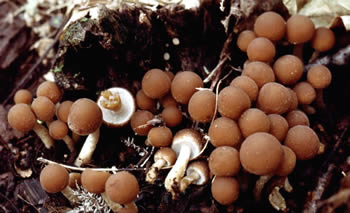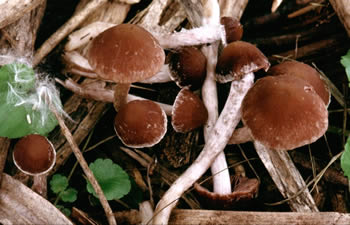Psathyrella hydrophila
Scientific name: Psathyrella hydrophila (Bull.) Maire
Derivation of name: Psathyr- means "crumbly" and
ella is a diminutive to distinguish the genus from
Psathrya. Hydr- means "water" and phil- means"loving"
or "fond of."
Synonyms: Agaricus hydrophilus Bull.
Common name(s): Clustered Psathyrella.
Phylum: Basidiomycota
Order: Agaricales
Family: Psathyrellaceae
Occurrence on wood substrate: Saprobic; in dense cespitose
clusters on decaying deciduous stumps and logs, at the base of
trees or stumps, or on buried wood.
Dimensions: Caps 2.5-5 cm wide; stipes 2.5-15 cm long and
2-5 mm thick.
Cap: Moist; dark brownish at first, fading to honey-brown or
tan.
Gills: Attached; buff, becoming brown to purple-brown.
Spore print: Purple-brown.
Stipe: Whitish.
Veil: Delicate, not leaving a ring.
Comments: A look-alike species is P. septentrionalis which,
unlike P. hydrophila, has white, tooth-like pieces of partial
veil hanging from the cap margin. P. hydrophila lacks these
veil remnants.
The two species are most reliably separated
from each other by spore size measurements.

Figure 1. Dense cespitose fruiting of Clustered Psathyrella.
Photo © Steve Nelsen.

Figure 2. Stalks of Psathyrella hydrophila are hollow and
fragile. Photo © Steve Nelsen.